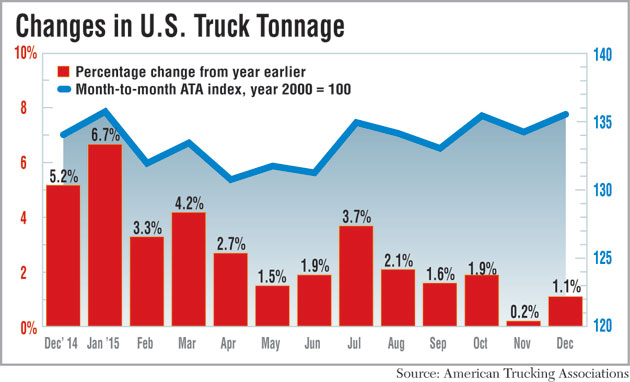December Tonnage Climbs 1.1% as Inventory Growth Slows

Truck tonnage rose 1.1% in December over the same month of 2014, as growth continues to be held back by excessive inventories that are reducing freight demand, American Trucking Associations reported.
The federation’s advanced seasonally adjusted tonnage index reached 135.6 in December after a 1% rise the previous month. The gain on a month-to-month basis brought the for-hire index closer to the all-time record of 135.8 set in January 2015.
Last month’s results also brought the full-year tonnage growth to 2.6%, capping a year when the tonnage report showed particularly slow growth over the final four months, including a rise of just 0.2% in November.
“Tonnage ended 2015 on a strong note, but it was not strong for the year as a whole,” ATA Chief Economist Bob Costello said. “With year-over-year gains averaging just 1.2% over the last four months, there was a clear deceleration in truck tonnage.”
“I remain concerned about the high level of inventories throughout the supply chain,” he said, pointing to an inventory-to-sales ratio that is the worst in more than a decade, excluding the recession. “This inventory cycle is overriding any strength from consumer spending and housing at the moment.”
Costello told Transport Topics that weak factory output and the lack of energy exploration for oil and natural gas continue to be key factors in the slowing tonnage growth.
Earlier this month, the Institute for Supply Management index of factory activity reached the lowest level since June 2009. In addition, oil-field services firm Baker Hughes said energy exploration has fallen 60% over the past year.
ATA’s Costello said that “until the inventory issue is worked out, more than the other two drags, there will be pressure on freight volumes generally, including tonnage.”
Costello is maintaining his forecast that tonnage will rise 2% to 3% this year, in line with gross domestic product growth of 2.6% to 2.8%.
December truck tonnage growth exceeded the 10-year average of 0.7% for the final month of the year, a Deutsche Bank report noted.
ATA also said the non-seasonally adjusted tonnage reading, measuring actual freight moves, was 132.7 in December, up 2.9% sequentially, and 0.9% for the year.
Costello said that “too many people are looking at the stock market as a reflection on the economy generally. I believe that is a mistake. The stock market is more susceptible to the international markets than the economy actually is.”
Jim Meil, principal for industry analysis at ACT Research, told TT on Jan. 20, “We still think slow growth in the economy is the right hypothesis, but there is a little more concern about the downside than there was on Dec. 31, due to the hypersensitive stock market.”
Shares of the Standard and Poor’s 500 index have lost about 9% of their value since the start of this year. Meil noted that financial markets also had short dips in both 2014 and 2015 before recovering.
Thom Albrecht, a BB&T Capital Markets analyst, said truck tonnage has been sending different signals from the stock market, particularly his firm’s trucking index, which fell about 35% last year.
“This phenomenon of the stocks declining materially ahead of truck tonnage entering a period of consistent declines is a stark contrast to the last two downturns, 2001 and 2007, when stock declines were coincident with or even lagged tonnage declines,” he said.
His report cited multiple reasons for the contrast between trucking shares and freight tonnage, including investors who are wary now after missing warning signs before the last recession, concerns about global industrial weakness, particularly in China, and an absence of robust economic growth since 2009.
“Investors are constantly looking over their shoulders due to weak GDP,” Albrecht said. “While questions exist about 2016, the narrative to be positive about tightening capacity in 2017 and 2018 is real, including new regulations, weak truck orders, modest driver pay increases in 2016 [creating a problem in 2017] and a likely sharp acceleration in pricing.”
Meil also outlined several key economic forces for 2016, largely tied to low fuel prices that have helped fleets.
On the plus side, the economy was helped in December as automakers finished a record year, and low prices have helped chemicals and plastics manufacturers that depend on petroleum products for feedstocks.
Also in the positive column is the housing market, where home sales, construction and prices have rebounded.
However, there are “a lot of manufacturers that are flatlining or are in a state of decline,” he said, particularly equipment manufacturers and exporters,” he said.
“Commodities such as coal and copper are suffering, too,” Meil added. “If you are [energy producers in] Texas, North Dakota or Canada, you are feeling some real hurt, and already in a recession.”




